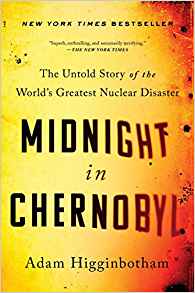Adam Higginbotham is the author of the new book Midnight in Chernobyl: The Untold Story of the World's Greatest Nuclear Disaster. He writes for a variety of publications, including The New Yorker and The New York Times Magazine, and he lives in New York City.
Q: You note that you’ve been interviewing people about
Chernobyl for more than a decade. What first got you interested in the topic,
and at what point did you decide to write this book?
A: I grew up in England at the height of the Cold War, and
was 17 when the accident happened, so the catastrophe—and the wider sense of
nuclear terror that enveloped much of the world at the time—has always informed
my outlook.
But I first began research into the topic at the end of
2005, ahead of the 20th anniversary of the disaster, when I set out to report a
magazine story about the night of the accident based on the recollections of
surviving eyewitnesses.
The experiences of the people I met on those first visits to
Moscow and Kiev made such an impression on me that I immediately knew there was
a powerful book-length narrative to be written about the full story of the
accident, but at the time no-one was interested in publishing one.
Nevertheless, I returned to Chernobyl again in 2011 to report a second magazine
story—this time about the long-term consequences of the disaster.
The same month my piece was published, the Fukushima
accident took place, and what many people had regarded as an old story suddenly
became newly relevant. And although on that trip I found my experiences inside
the Exclusion Zone sufficiently frightening that I swore I would never return,
the stories of the people I had met never left me, and a few years later I
found myself writing another magazine pitch—to widespread disinterest.
At that point, in 2014, I decided to write a book, began
work on a proposal, and it sold to S&S the following year.
Q: How did you research the book, in addition to the
interviews, and what did you learn that particularly surprised you?
A: I gathered information from as many sources as I could: I
found declassified documents and other primary materials including films and
photographs in archives in London, Harvard, Washington, D.C., Moscow and Kiev.
I found elusive Russian- and Ukrainian-language books and monographs through
the research division of the New York Public library system, online and through
the Russian equivalent of eBay.
I worked through an
enormous trove of medical scientific papers about almost every aspect of the
accident, from reactor physics to the effect of radiation on human beings. I
spoke to experts who guided me through the complexities of those subjects and
enabled me to translate them for a general reader. I had the help of
researchers in Kiev in Moscow who hunted down obscure journals and multi-volume
memoirs, and translators who rendered them into English.
Q: What do you see as some of the most common perceptions
and misperceptions about the Chernobyl disaster?
A: There are many misconceptions about the disaster: some of
the major ones spring from the initial attempts by the Soviet government to
cover up the true scale of what happened.
For example, Western foreign correspondents in Moscow were
deprived of access to first-hand information in the days after the accident,
and did their best with rumors and hearsay. The New York Post reported at the
time that 15,000 people had been killed almost immediately by the accident, and
their bodies buried as nuclear waste; as a result many people today still
believe thousands died as a result of the initial explosion.
Deliberate misinformation and confusion about the true
nature of radioactivity mean that many people believe hundreds of thousands of
people have since died of cancer directly attributable to the accident,
although there is little or no scientific evidence to support such an
assertion.
Other widespread notions of the accident have their roots in
the Soviet propaganda narrative of the accident, built around the actions of
incompetent plant staff and the selfless sacrifice of firefighters sent to the
scene after the explosion; the truth, naturally, is more complex and compelling
than that.
Q: What impact do you think the disaster had on the Soviet
Union, and what do you see as Chernobyl’s legacy today?
A: The disaster was a key moment on the path to the
disintegration of the USSR: it had a profound effect on the approach to reform
taken by General Secretary Mikhail Gorbachev. Only after the accident did he
realize the true scale of the rot at the heart of the heart of the Soviet
system, and what he learned convinced him that, in order to save the USSR, he
had to plunge swiftly and deeply into economic and political reform.
In the event, these reforms were botched and badly planned,
and proved to be the undoing of the system Gorbachev hoped to preserve; at the
same time, Chernobyl proved to be a test case in the more open government
promised by the notion of glasnost, revealing to the Soviet people much about
the lies and incompetence that had led to the accident, and, eventually, the
cover-up that followed. After Chernobyl, an already distrustful public could
never put their faith in their leaders again.
The legacy of the accident endures both on the land
contaminated by it and among the people whose lives were overturned or
destroyed by it—and in the resulting distrust the public has for nuclear energy
in any form.
Q: What are you working on now?
A: Right now I’m still spending a lot of time doing public
appearances and talking about the book and the stories in it. But I have a
couple of new narrative projects that I’ve been planning for a while, and I
hope will keep me busy when I return to my desk...
--Interview with Deborah Kalb


No comments:
Post a Comment